PUBH6006: Community Health and Disease Prevention Essay
VerifiedAdded on 2021/03/26
|7
|2157
|182
Essay
AI Summary
This essay provides an in-depth analysis of the National Diabetes Prevention Program (DPP) in the USA, focusing on its strategies and frameworks for community health and disease prevention, specifically targeting prediabetes and type 2 diabetes. The essay begins by highlighting the increasing prevalence of diabetes globally and the importance of preventive measures, such as lifestyle changes, which are at the core of the DPP. It explores the program's target population, risk factors for type 2 diabetes, and the conceptual framework of community-based health promotion, emphasizing the Ottawa Charter's five actions. The essay further examines community empowerment within the DPP, emphasizing the role of health communication and community capacity building. It concludes by summarizing the DPP's impact on promoting health and motivating communities through cost-effective interventions and a dynamic group interaction mechanism designed to support at-risk individuals. The essay references key data and reports from the International Diabetes Federation and the World Health Organization, and provides a detailed overview of the program's structure and objectives.
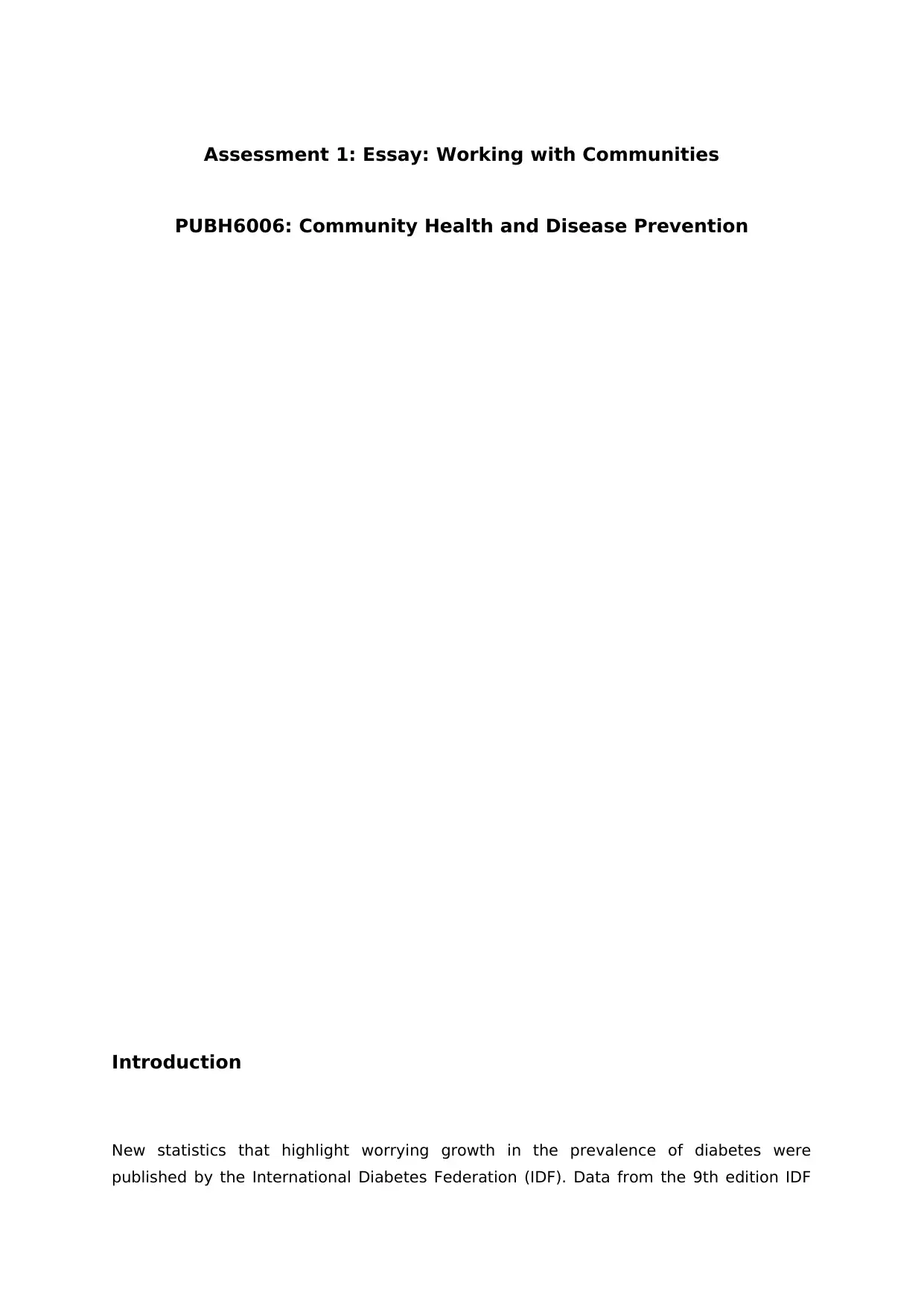
Assessment 1: Essay: Working with Communities
PUBH6006: Community Health and Disease Prevention
Introduction
New statistics that highlight worrying growth in the prevalence of diabetes were
published by the International Diabetes Federation (IDF). Data from the 9th edition IDF
PUBH6006: Community Health and Disease Prevention
Introduction
New statistics that highlight worrying growth in the prevalence of diabetes were
published by the International Diabetes Federation (IDF). Data from the 9th edition IDF
Paraphrase This Document
Need a fresh take? Get an instant paraphrase of this document with our AI Paraphraser
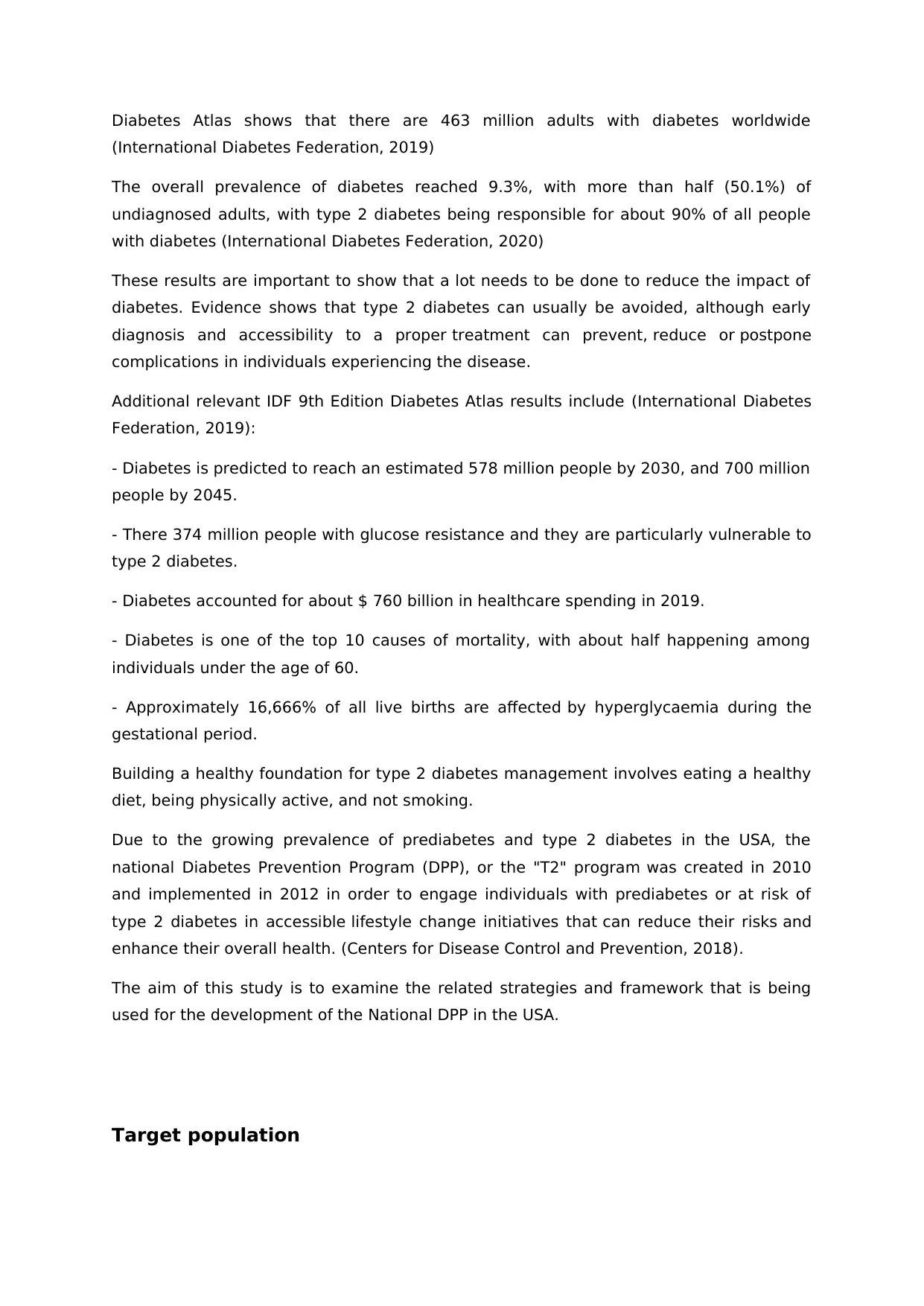
Diabetes Atlas shows that there are 463 million adults with diabetes worldwide
(International Diabetes Federation, 2019)
The overall prevalence of diabetes reached 9.3%, with more than half (50.1%) of
undiagnosed adults, with type 2 diabetes being responsible for about 90% of all people
with diabetes (International Diabetes Federation, 2020)
These results are important to show that a lot needs to be done to reduce the impact of
diabetes. Evidence shows that type 2 diabetes can usually be avoided, although early
diagnosis and accessibility to a proper treatment can prevent, reduce or postpone
complications in individuals experiencing the disease.
Additional relevant IDF 9th Edition Diabetes Atlas results include (International Diabetes
Federation, 2019):
- Diabetes is predicted to reach an estimated 578 million people by 2030, and 700 million
people by 2045.
- There 374 million people with glucose resistance and they are particularly vulnerable to
type 2 diabetes.
- Diabetes accounted for about $ 760 billion in healthcare spending in 2019.
- Diabetes is one of the top 10 causes of mortality, with about half happening among
individuals under the age of 60.
- Approximately 16,666% of all live births are affected by hyperglycaemia during the
gestational period.
Building a healthy foundation for type 2 diabetes management involves eating a healthy
diet, being physically active, and not smoking.
Due to the growing prevalence of prediabetes and type 2 diabetes in the USA, the
national Diabetes Prevention Program (DPP), or the "T2" program was created in 2010
and implemented in 2012 in order to engage individuals with prediabetes or at risk of
type 2 diabetes in accessible lifestyle change initiatives that can reduce their risks and
enhance their overall health. (Centers for Disease Control and Prevention, 2018).
The aim of this study is to examine the related strategies and framework that is being
used for the development of the National DPP in the USA.
Target population
(International Diabetes Federation, 2019)
The overall prevalence of diabetes reached 9.3%, with more than half (50.1%) of
undiagnosed adults, with type 2 diabetes being responsible for about 90% of all people
with diabetes (International Diabetes Federation, 2020)
These results are important to show that a lot needs to be done to reduce the impact of
diabetes. Evidence shows that type 2 diabetes can usually be avoided, although early
diagnosis and accessibility to a proper treatment can prevent, reduce or postpone
complications in individuals experiencing the disease.
Additional relevant IDF 9th Edition Diabetes Atlas results include (International Diabetes
Federation, 2019):
- Diabetes is predicted to reach an estimated 578 million people by 2030, and 700 million
people by 2045.
- There 374 million people with glucose resistance and they are particularly vulnerable to
type 2 diabetes.
- Diabetes accounted for about $ 760 billion in healthcare spending in 2019.
- Diabetes is one of the top 10 causes of mortality, with about half happening among
individuals under the age of 60.
- Approximately 16,666% of all live births are affected by hyperglycaemia during the
gestational period.
Building a healthy foundation for type 2 diabetes management involves eating a healthy
diet, being physically active, and not smoking.
Due to the growing prevalence of prediabetes and type 2 diabetes in the USA, the
national Diabetes Prevention Program (DPP), or the "T2" program was created in 2010
and implemented in 2012 in order to engage individuals with prediabetes or at risk of
type 2 diabetes in accessible lifestyle change initiatives that can reduce their risks and
enhance their overall health. (Centers for Disease Control and Prevention, 2018).
The aim of this study is to examine the related strategies and framework that is being
used for the development of the National DPP in the USA.
Target population
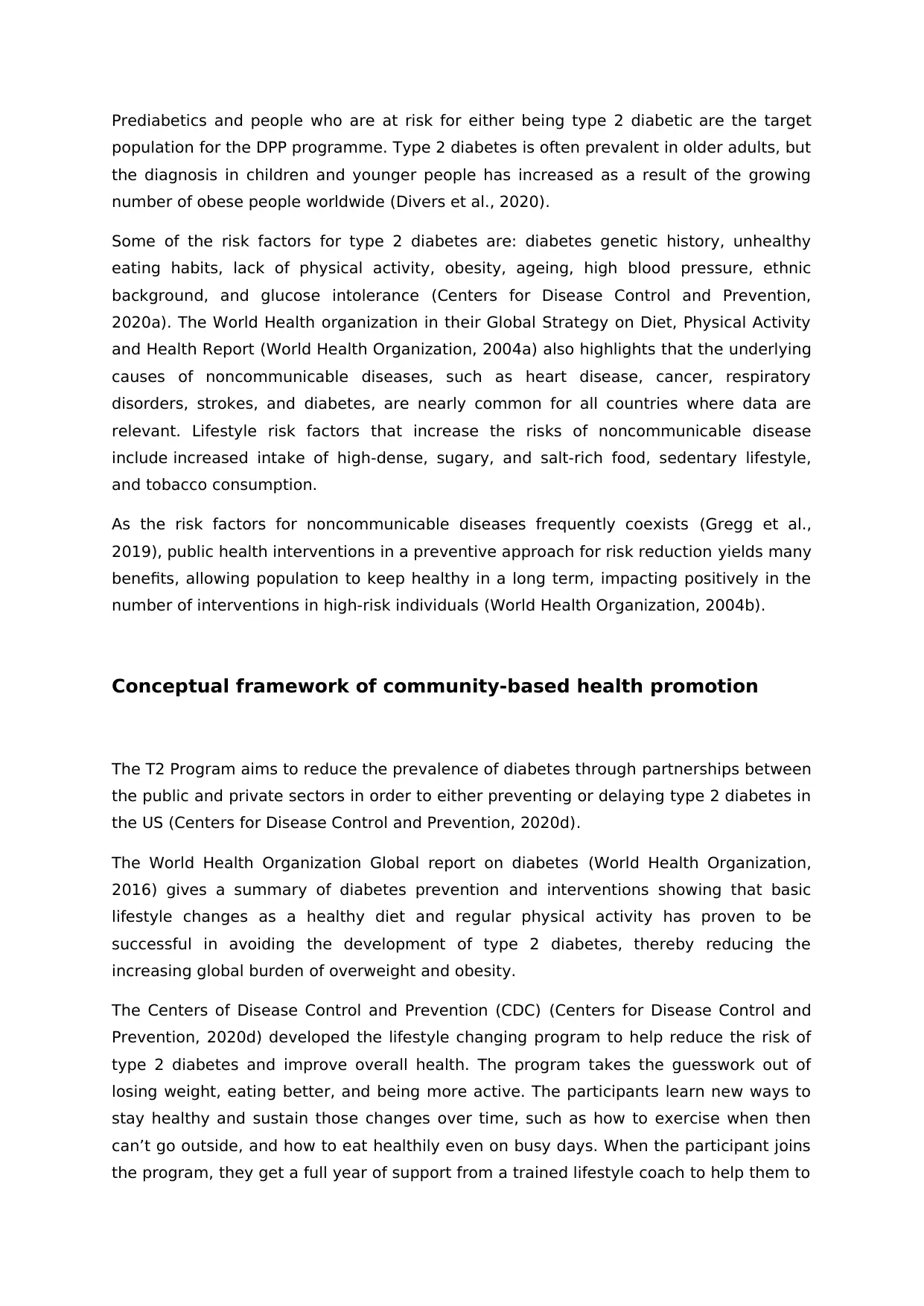
Prediabetics and people who are at risk for either being type 2 diabetic are the target
population for the DPP programme. Type 2 diabetes is often prevalent in older adults, but
the diagnosis in children and younger people has increased as a result of the growing
number of obese people worldwide (Divers et al., 2020).
Some of the risk factors for type 2 diabetes are: diabetes genetic history, unhealthy
eating habits, lack of physical activity, obesity, ageing, high blood pressure, ethnic
background, and glucose intolerance (Centers for Disease Control and Prevention,
2020a). The World Health organization in their Global Strategy on Diet, Physical Activity
and Health Report (World Health Organization, 2004a) also highlights that the underlying
causes of noncommunicable diseases, such as heart disease, cancer, respiratory
disorders, strokes, and diabetes, are nearly common for all countries where data are
relevant. Lifestyle risk factors that increase the risks of noncommunicable disease
include increased intake of high-dense, sugary, and salt-rich food, sedentary lifestyle,
and tobacco consumption.
As the risk factors for noncommunicable diseases frequently coexists (Gregg et al.,
2019), public health interventions in a preventive approach for risk reduction yields many
benefits, allowing population to keep healthy in a long term, impacting positively in the
number of interventions in high-risk individuals (World Health Organization, 2004b).
Conceptual framework of community-based health promotion
The T2 Program aims to reduce the prevalence of diabetes through partnerships between
the public and private sectors in order to either preventing or delaying type 2 diabetes in
the US (Centers for Disease Control and Prevention, 2020d).
The World Health Organization Global report on diabetes (World Health Organization,
2016) gives a summary of diabetes prevention and interventions showing that basic
lifestyle changes as a healthy diet and regular physical activity has proven to be
successful in avoiding the development of type 2 diabetes, thereby reducing the
increasing global burden of overweight and obesity.
The Centers of Disease Control and Prevention (CDC) (Centers for Disease Control and
Prevention, 2020d) developed the lifestyle changing program to help reduce the risk of
type 2 diabetes and improve overall health. The program takes the guesswork out of
losing weight, eating better, and being more active. The participants learn new ways to
stay healthy and sustain those changes over time, such as how to exercise when then
can’t go outside, and how to eat healthily even on busy days. When the participant joins
the program, they get a full year of support from a trained lifestyle coach to help them to
population for the DPP programme. Type 2 diabetes is often prevalent in older adults, but
the diagnosis in children and younger people has increased as a result of the growing
number of obese people worldwide (Divers et al., 2020).
Some of the risk factors for type 2 diabetes are: diabetes genetic history, unhealthy
eating habits, lack of physical activity, obesity, ageing, high blood pressure, ethnic
background, and glucose intolerance (Centers for Disease Control and Prevention,
2020a). The World Health organization in their Global Strategy on Diet, Physical Activity
and Health Report (World Health Organization, 2004a) also highlights that the underlying
causes of noncommunicable diseases, such as heart disease, cancer, respiratory
disorders, strokes, and diabetes, are nearly common for all countries where data are
relevant. Lifestyle risk factors that increase the risks of noncommunicable disease
include increased intake of high-dense, sugary, and salt-rich food, sedentary lifestyle,
and tobacco consumption.
As the risk factors for noncommunicable diseases frequently coexists (Gregg et al.,
2019), public health interventions in a preventive approach for risk reduction yields many
benefits, allowing population to keep healthy in a long term, impacting positively in the
number of interventions in high-risk individuals (World Health Organization, 2004b).
Conceptual framework of community-based health promotion
The T2 Program aims to reduce the prevalence of diabetes through partnerships between
the public and private sectors in order to either preventing or delaying type 2 diabetes in
the US (Centers for Disease Control and Prevention, 2020d).
The World Health Organization Global report on diabetes (World Health Organization,
2016) gives a summary of diabetes prevention and interventions showing that basic
lifestyle changes as a healthy diet and regular physical activity has proven to be
successful in avoiding the development of type 2 diabetes, thereby reducing the
increasing global burden of overweight and obesity.
The Centers of Disease Control and Prevention (CDC) (Centers for Disease Control and
Prevention, 2020d) developed the lifestyle changing program to help reduce the risk of
type 2 diabetes and improve overall health. The program takes the guesswork out of
losing weight, eating better, and being more active. The participants learn new ways to
stay healthy and sustain those changes over time, such as how to exercise when then
can’t go outside, and how to eat healthily even on busy days. When the participant joins
the program, they get a full year of support from a trained lifestyle coach to help them to
⊘ This is a preview!⊘
Do you want full access?
Subscribe today to unlock all pages.

Trusted by 1+ million students worldwide
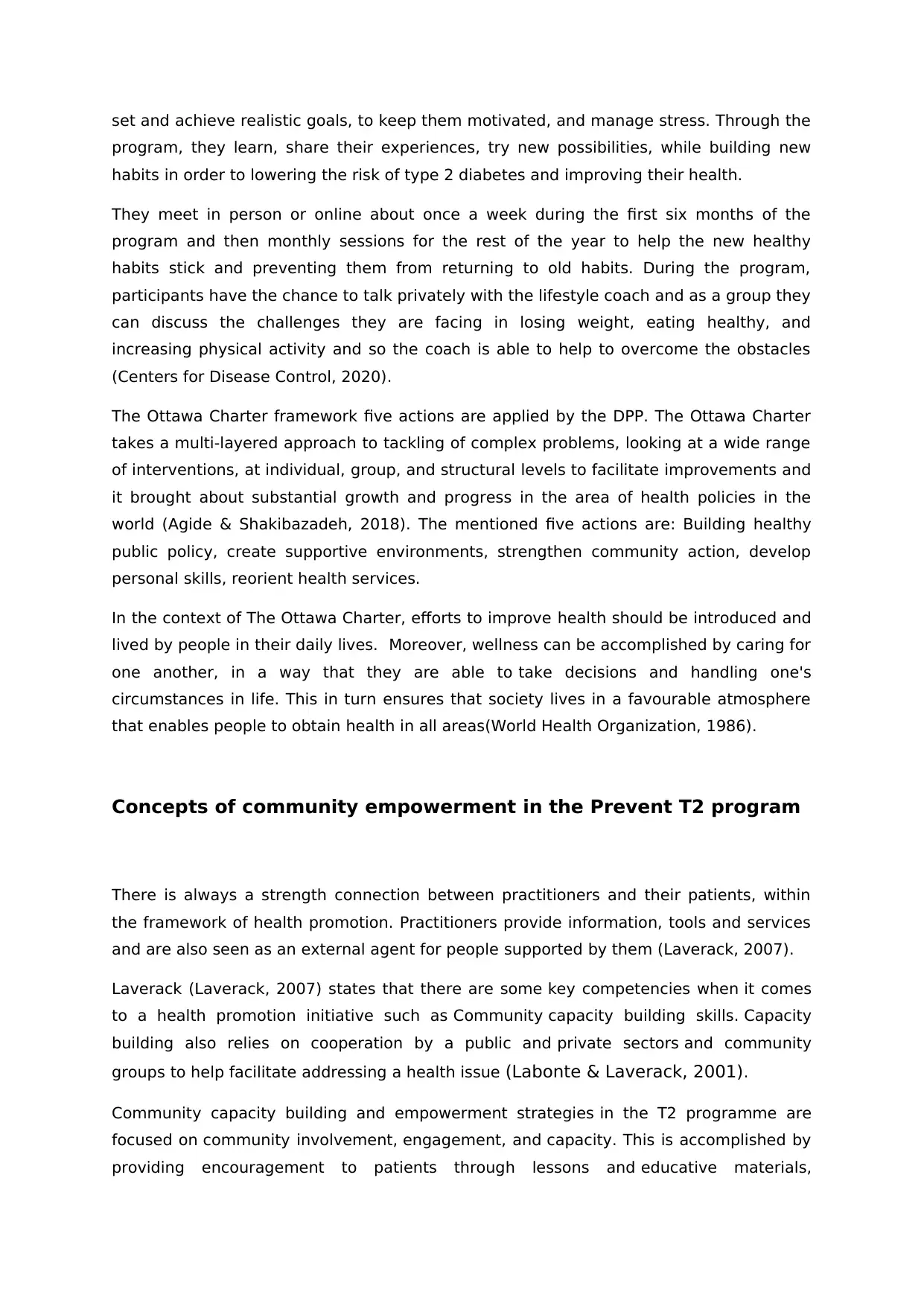
set and achieve realistic goals, to keep them motivated, and manage stress. Through the
program, they learn, share their experiences, try new possibilities, while building new
habits in order to lowering the risk of type 2 diabetes and improving their health.
They meet in person or online about once a week during the first six months of the
program and then monthly sessions for the rest of the year to help the new healthy
habits stick and preventing them from returning to old habits. During the program,
participants have the chance to talk privately with the lifestyle coach and as a group they
can discuss the challenges they are facing in losing weight, eating healthy, and
increasing physical activity and so the coach is able to help to overcome the obstacles
(Centers for Disease Control, 2020).
The Ottawa Charter framework five actions are applied by the DPP. The Ottawa Charter
takes a multi-layered approach to tackling of complex problems, looking at a wide range
of interventions, at individual, group, and structural levels to facilitate improvements and
it brought about substantial growth and progress in the area of health policies in the
world (Agide & Shakibazadeh, 2018). The mentioned five actions are: Building healthy
public policy, create supportive environments, strengthen community action, develop
personal skills, reorient health services.
In the context of The Ottawa Charter, efforts to improve health should be introduced and
lived by people in their daily lives. Moreover, wellness can be accomplished by caring for
one another, in a way that they are able to take decisions and handling one's
circumstances in life. This in turn ensures that society lives in a favourable atmosphere
that enables people to obtain health in all areas(World Health Organization, 1986).
Concepts of community empowerment in the Prevent T2 program
There is always a strength connection between practitioners and their patients, within
the framework of health promotion. Practitioners provide information, tools and services
and are also seen as an external agent for people supported by them (Laverack, 2007).
Laverack (Laverack, 2007) states that there are some key competencies when it comes
to a health promotion initiative such as Community capacity building skills. Capacity
building also relies on cooperation by a public and private sectors and community
groups to help facilitate addressing a health issue (Labonte & Laverack, 2001).
Community capacity building and empowerment strategies in the T2 programme are
focused on community involvement, engagement, and capacity. This is accomplished by
providing encouragement to patients through lessons and educative materials,
program, they learn, share their experiences, try new possibilities, while building new
habits in order to lowering the risk of type 2 diabetes and improving their health.
They meet in person or online about once a week during the first six months of the
program and then monthly sessions for the rest of the year to help the new healthy
habits stick and preventing them from returning to old habits. During the program,
participants have the chance to talk privately with the lifestyle coach and as a group they
can discuss the challenges they are facing in losing weight, eating healthy, and
increasing physical activity and so the coach is able to help to overcome the obstacles
(Centers for Disease Control, 2020).
The Ottawa Charter framework five actions are applied by the DPP. The Ottawa Charter
takes a multi-layered approach to tackling of complex problems, looking at a wide range
of interventions, at individual, group, and structural levels to facilitate improvements and
it brought about substantial growth and progress in the area of health policies in the
world (Agide & Shakibazadeh, 2018). The mentioned five actions are: Building healthy
public policy, create supportive environments, strengthen community action, develop
personal skills, reorient health services.
In the context of The Ottawa Charter, efforts to improve health should be introduced and
lived by people in their daily lives. Moreover, wellness can be accomplished by caring for
one another, in a way that they are able to take decisions and handling one's
circumstances in life. This in turn ensures that society lives in a favourable atmosphere
that enables people to obtain health in all areas(World Health Organization, 1986).
Concepts of community empowerment in the Prevent T2 program
There is always a strength connection between practitioners and their patients, within
the framework of health promotion. Practitioners provide information, tools and services
and are also seen as an external agent for people supported by them (Laverack, 2007).
Laverack (Laverack, 2007) states that there are some key competencies when it comes
to a health promotion initiative such as Community capacity building skills. Capacity
building also relies on cooperation by a public and private sectors and community
groups to help facilitate addressing a health issue (Labonte & Laverack, 2001).
Community capacity building and empowerment strategies in the T2 programme are
focused on community involvement, engagement, and capacity. This is accomplished by
providing encouragement to patients through lessons and educative materials,
Paraphrase This Document
Need a fresh take? Get an instant paraphrase of this document with our AI Paraphraser
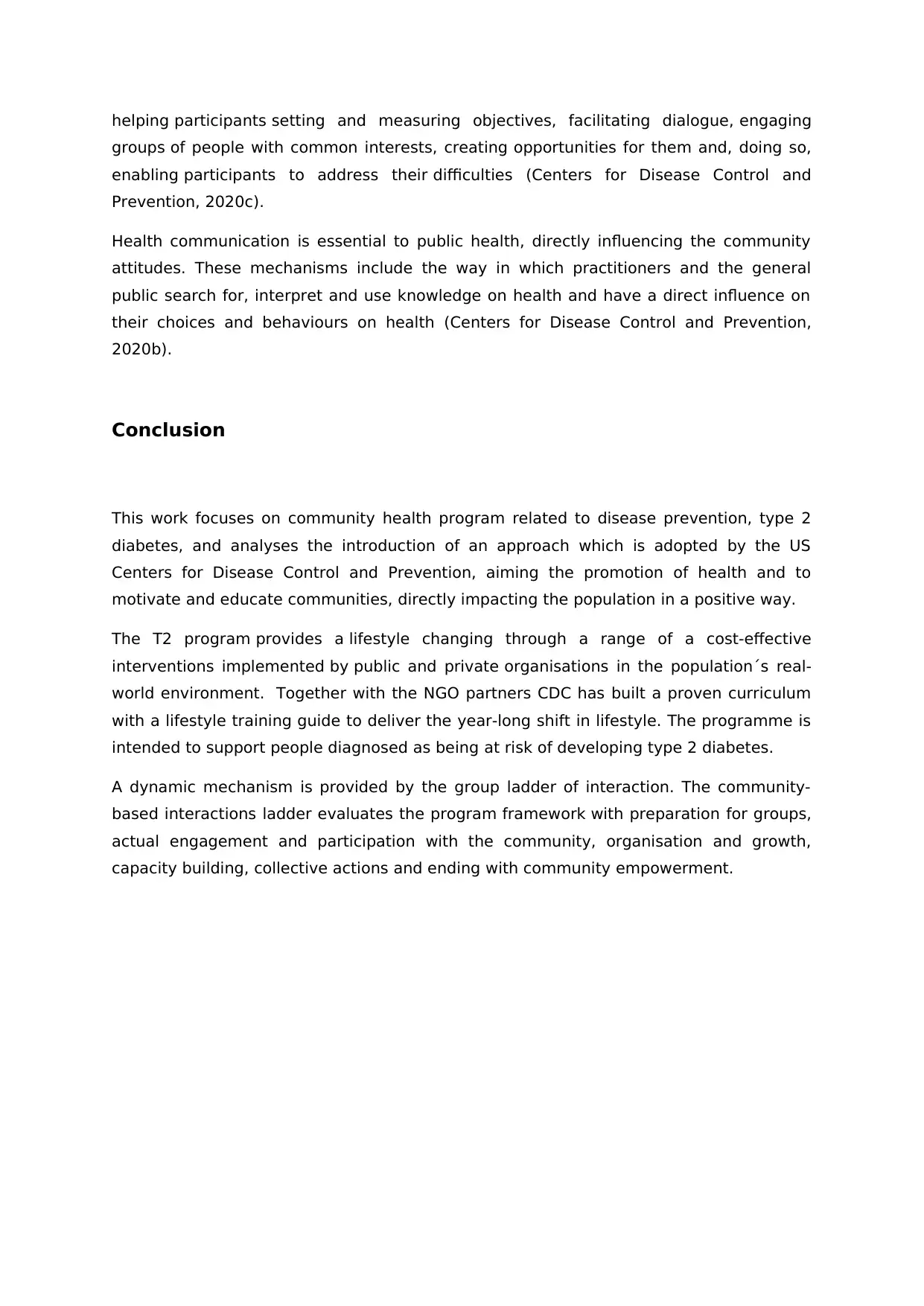
helping participants setting and measuring objectives, facilitating dialogue, engaging
groups of people with common interests, creating opportunities for them and, doing so,
enabling participants to address their difficulties (Centers for Disease Control and
Prevention, 2020c).
Health communication is essential to public health, directly influencing the community
attitudes. These mechanisms include the way in which practitioners and the general
public search for, interpret and use knowledge on health and have a direct influence on
their choices and behaviours on health (Centers for Disease Control and Prevention,
2020b).
Conclusion
This work focuses on community health program related to disease prevention, type 2
diabetes, and analyses the introduction of an approach which is adopted by the US
Centers for Disease Control and Prevention, aiming the promotion of health and to
motivate and educate communities, directly impacting the population in a positive way.
The T2 program provides a lifestyle changing through a range of a cost-effective
interventions implemented by public and private organisations in the population´s real-
world environment. Together with the NGO partners CDC has built a proven curriculum
with a lifestyle training guide to deliver the year-long shift in lifestyle. The programme is
intended to support people diagnosed as being at risk of developing type 2 diabetes.
A dynamic mechanism is provided by the group ladder of interaction. The community-
based interactions ladder evaluates the program framework with preparation for groups,
actual engagement and participation with the community, organisation and growth,
capacity building, collective actions and ending with community empowerment.
groups of people with common interests, creating opportunities for them and, doing so,
enabling participants to address their difficulties (Centers for Disease Control and
Prevention, 2020c).
Health communication is essential to public health, directly influencing the community
attitudes. These mechanisms include the way in which practitioners and the general
public search for, interpret and use knowledge on health and have a direct influence on
their choices and behaviours on health (Centers for Disease Control and Prevention,
2020b).
Conclusion
This work focuses on community health program related to disease prevention, type 2
diabetes, and analyses the introduction of an approach which is adopted by the US
Centers for Disease Control and Prevention, aiming the promotion of health and to
motivate and educate communities, directly impacting the population in a positive way.
The T2 program provides a lifestyle changing through a range of a cost-effective
interventions implemented by public and private organisations in the population´s real-
world environment. Together with the NGO partners CDC has built a proven curriculum
with a lifestyle training guide to deliver the year-long shift in lifestyle. The programme is
intended to support people diagnosed as being at risk of developing type 2 diabetes.
A dynamic mechanism is provided by the group ladder of interaction. The community-
based interactions ladder evaluates the program framework with preparation for groups,
actual engagement and participation with the community, organisation and growth,
capacity building, collective actions and ending with community empowerment.
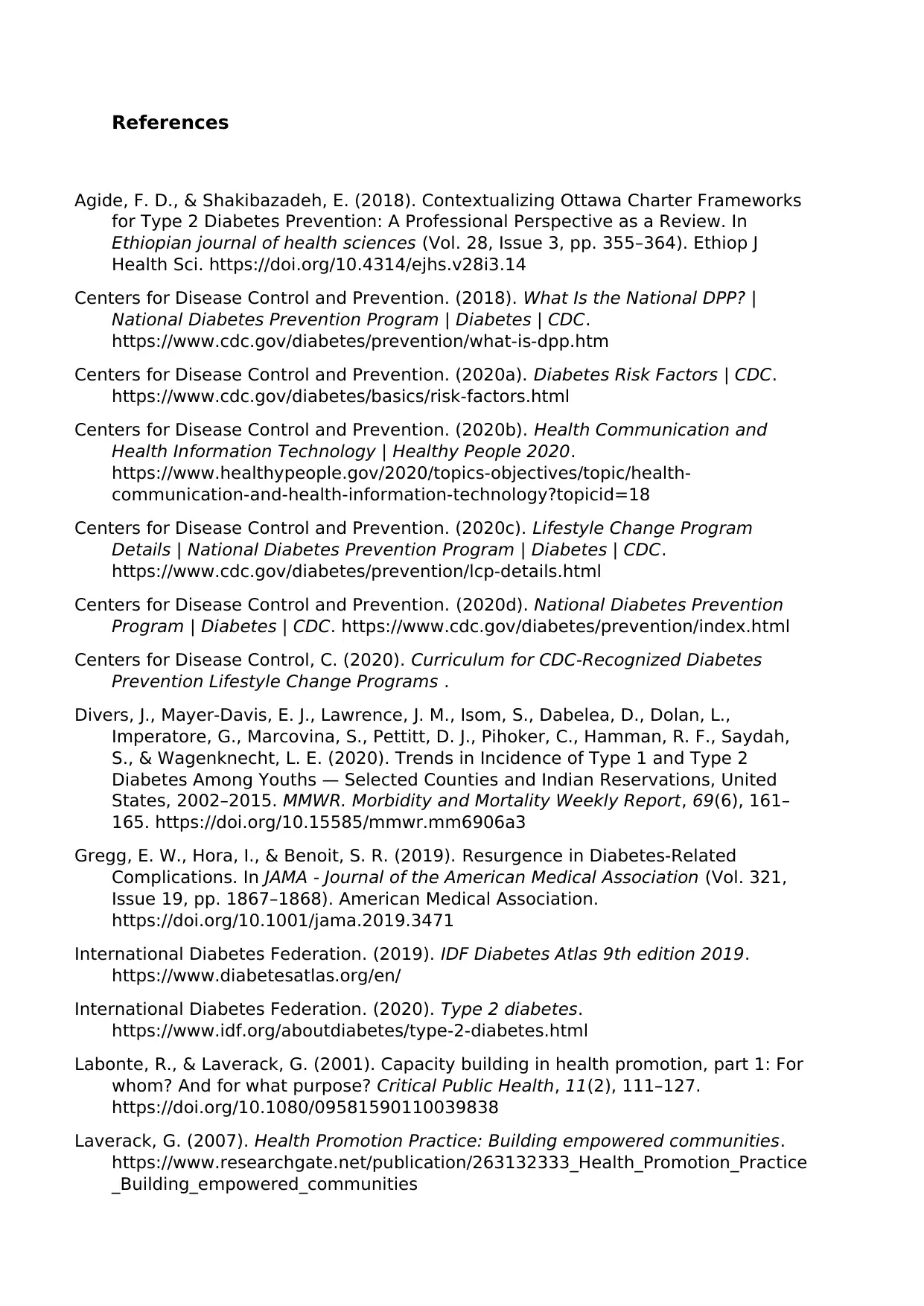
References
Agide, F. D., & Shakibazadeh, E. (2018). Contextualizing Ottawa Charter Frameworks
for Type 2 Diabetes Prevention: A Professional Perspective as a Review. In
Ethiopian journal of health sciences (Vol. 28, Issue 3, pp. 355–364). Ethiop J
Health Sci. https://doi.org/10.4314/ejhs.v28i3.14
Centers for Disease Control and Prevention. (2018). What Is the National DPP? |
National Diabetes Prevention Program | Diabetes | CDC.
https://www.cdc.gov/diabetes/prevention/what-is-dpp.htm
Centers for Disease Control and Prevention. (2020a). Diabetes Risk Factors | CDC.
https://www.cdc.gov/diabetes/basics/risk-factors.html
Centers for Disease Control and Prevention. (2020b). Health Communication and
Health Information Technology | Healthy People 2020.
https://www.healthypeople.gov/2020/topics-objectives/topic/health-
communication-and-health-information-technology?topicid=18
Centers for Disease Control and Prevention. (2020c). Lifestyle Change Program
Details | National Diabetes Prevention Program | Diabetes | CDC.
https://www.cdc.gov/diabetes/prevention/lcp-details.html
Centers for Disease Control and Prevention. (2020d). National Diabetes Prevention
Program | Diabetes | CDC. https://www.cdc.gov/diabetes/prevention/index.html
Centers for Disease Control, C. (2020). Curriculum for CDC-Recognized Diabetes
Prevention Lifestyle Change Programs .
Divers, J., Mayer-Davis, E. J., Lawrence, J. M., Isom, S., Dabelea, D., Dolan, L.,
Imperatore, G., Marcovina, S., Pettitt, D. J., Pihoker, C., Hamman, R. F., Saydah,
S., & Wagenknecht, L. E. (2020). Trends in Incidence of Type 1 and Type 2
Diabetes Among Youths — Selected Counties and Indian Reservations, United
States, 2002–2015. MMWR. Morbidity and Mortality Weekly Report, 69(6), 161–
165. https://doi.org/10.15585/mmwr.mm6906a3
Gregg, E. W., Hora, I., & Benoit, S. R. (2019). Resurgence in Diabetes-Related
Complications. In JAMA - Journal of the American Medical Association (Vol. 321,
Issue 19, pp. 1867–1868). American Medical Association.
https://doi.org/10.1001/jama.2019.3471
International Diabetes Federation. (2019). IDF Diabetes Atlas 9th edition 2019.
https://www.diabetesatlas.org/en/
International Diabetes Federation. (2020). Type 2 diabetes.
https://www.idf.org/aboutdiabetes/type-2-diabetes.html
Labonte, R., & Laverack, G. (2001). Capacity building in health promotion, part 1: For
whom? And for what purpose? Critical Public Health, 11(2), 111–127.
https://doi.org/10.1080/09581590110039838
Laverack, G. (2007). Health Promotion Practice: Building empowered communities.
https://www.researchgate.net/publication/263132333_Health_Promotion_Practice
_Building_empowered_communities
Agide, F. D., & Shakibazadeh, E. (2018). Contextualizing Ottawa Charter Frameworks
for Type 2 Diabetes Prevention: A Professional Perspective as a Review. In
Ethiopian journal of health sciences (Vol. 28, Issue 3, pp. 355–364). Ethiop J
Health Sci. https://doi.org/10.4314/ejhs.v28i3.14
Centers for Disease Control and Prevention. (2018). What Is the National DPP? |
National Diabetes Prevention Program | Diabetes | CDC.
https://www.cdc.gov/diabetes/prevention/what-is-dpp.htm
Centers for Disease Control and Prevention. (2020a). Diabetes Risk Factors | CDC.
https://www.cdc.gov/diabetes/basics/risk-factors.html
Centers for Disease Control and Prevention. (2020b). Health Communication and
Health Information Technology | Healthy People 2020.
https://www.healthypeople.gov/2020/topics-objectives/topic/health-
communication-and-health-information-technology?topicid=18
Centers for Disease Control and Prevention. (2020c). Lifestyle Change Program
Details | National Diabetes Prevention Program | Diabetes | CDC.
https://www.cdc.gov/diabetes/prevention/lcp-details.html
Centers for Disease Control and Prevention. (2020d). National Diabetes Prevention
Program | Diabetes | CDC. https://www.cdc.gov/diabetes/prevention/index.html
Centers for Disease Control, C. (2020). Curriculum for CDC-Recognized Diabetes
Prevention Lifestyle Change Programs .
Divers, J., Mayer-Davis, E. J., Lawrence, J. M., Isom, S., Dabelea, D., Dolan, L.,
Imperatore, G., Marcovina, S., Pettitt, D. J., Pihoker, C., Hamman, R. F., Saydah,
S., & Wagenknecht, L. E. (2020). Trends in Incidence of Type 1 and Type 2
Diabetes Among Youths — Selected Counties and Indian Reservations, United
States, 2002–2015. MMWR. Morbidity and Mortality Weekly Report, 69(6), 161–
165. https://doi.org/10.15585/mmwr.mm6906a3
Gregg, E. W., Hora, I., & Benoit, S. R. (2019). Resurgence in Diabetes-Related
Complications. In JAMA - Journal of the American Medical Association (Vol. 321,
Issue 19, pp. 1867–1868). American Medical Association.
https://doi.org/10.1001/jama.2019.3471
International Diabetes Federation. (2019). IDF Diabetes Atlas 9th edition 2019.
https://www.diabetesatlas.org/en/
International Diabetes Federation. (2020). Type 2 diabetes.
https://www.idf.org/aboutdiabetes/type-2-diabetes.html
Labonte, R., & Laverack, G. (2001). Capacity building in health promotion, part 1: For
whom? And for what purpose? Critical Public Health, 11(2), 111–127.
https://doi.org/10.1080/09581590110039838
Laverack, G. (2007). Health Promotion Practice: Building empowered communities.
https://www.researchgate.net/publication/263132333_Health_Promotion_Practice
_Building_empowered_communities
⊘ This is a preview!⊘
Do you want full access?
Subscribe today to unlock all pages.

Trusted by 1+ million students worldwide

World Health Organization. (1986). Ottawa Charter for Health Promotion.
World Health Organization. (2004a). Global Strategy on Diet, Physical Activity and
Health.
World Health Organization. (2004b). Global Strategy on Diet, Physical Activity and
Health.
World Health Organization. (2016). Global report on diabetes.
https://www.who.int/publications/i/item/9789241565257
World Health Organization. (2004a). Global Strategy on Diet, Physical Activity and
Health.
World Health Organization. (2004b). Global Strategy on Diet, Physical Activity and
Health.
World Health Organization. (2016). Global report on diabetes.
https://www.who.int/publications/i/item/9789241565257
1 out of 7
Related Documents
Your All-in-One AI-Powered Toolkit for Academic Success.
+13062052269
info@desklib.com
Available 24*7 on WhatsApp / Email
![[object Object]](/_next/static/media/star-bottom.7253800d.svg)
Unlock your academic potential
Copyright © 2020–2025 A2Z Services. All Rights Reserved. Developed and managed by ZUCOL.





